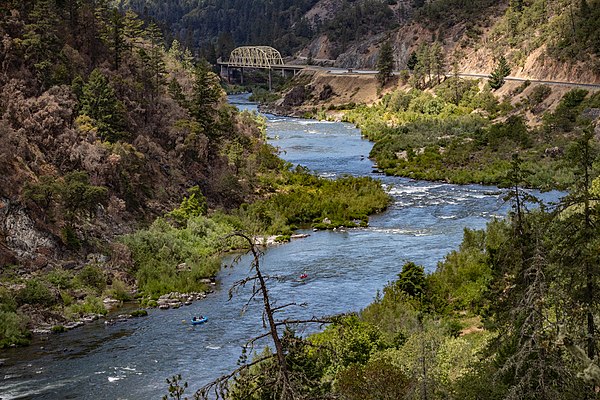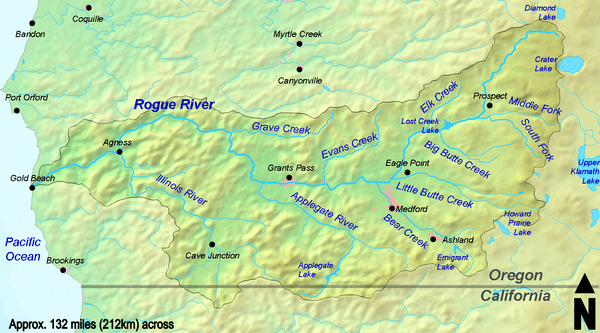I simply forgot it was Earth Day yesterday!
I wanted to let the post on Tuesday run for a couple of days because it really made the point about dogs, in particular, being animals who love to love!
But I then forgot, until I woke up on the 22nd, that yesterday was Earth Day.
So what to publish?
Yesterday in Merlin was a damp day with a steady rain coming down in the morning. About 10am I volunteered the idea that we should drive the shortish distance to Galice; just 10 miles from where we live. Galice is a very small settlement on the Western bank of the Rogue River. Then we drove on for a few more miles. It was incredible scenery. The misty, damp forest and the river running below in the gorge.
I had my camera with me and the following are some of the photographs that were taken.
Just for a change! All within 15 miles of home!

oooo

oooo

oooo

oooo

oooo

oooo

For those interested in learning more, I am publishing the WikiPedia account of the Rogue River.
The Rogue River (Tolowa: yan-shuu-chit’ taa-ghii~-li~’,[7] Takelma: tak-elam[8]) in southwestern Oregon in the United States flows about 215 miles (346 km) in a generally westward direction from the Cascade Range to the Pacific Ocean. Known for its salmon runs, whitewater rafting, and rugged scenery, it was one of the original eight rivers named in the Wild and Scenic Rivers Act of 1968. Beginning near Crater Lake, which occupies the caldera left by the explosive volcanic eruption of Mount Mazama, the river flows through the geologically young High Cascades and the older Western Cascades, another volcanic province. Further west, the river passes through multiple exotic terranes of the more ancient Klamath Mountains. In the Kalmiopsis Wilderness section of the Rogue basin are some of the world’s best examples of rocks that form the Earth’s mantle. Near the mouth of the river, the only dinosaur fragments ever discovered in Oregon were found in the Otter Point Formation, along the coast of Curry County.
People have lived along the Rogue River and its tributaries for at least 8,500 years. European explorers made first contact with Native Americans (Indians) toward the end of the 18th century and began beaver trapping and other activities in the region. Clashes, sometimes deadly, occurred between the natives and the trappers and later between the natives and European-American miners and settlers. These struggles culminated with the Rogue River Wars of 1855–56 and removal of most of the natives to reservations outside the basin. After the war, settlers expanded into remote areas of the watershed and established small farms along the river between Grave Creek and the mouth of the Illinois River. They were relatively isolated from the outside world until 1895, when the Post Office Department added mail-boat service along the lower Rogue. As of 2010, the Rogue has one of the two remaining rural mail-boat routes in the United States.
Dam building and removal along the Rogue has generated controversy for more than a century; an early fish-blocking dam (Ament) was dynamited by vigilantes, mostly disgruntled salmon fishermen. By 2009, all but one of the main-stem dams downstream of a huge flood-control structure 157 miles (253 km) from the river mouth had been removed. Aside from dams, threats to salmon include high water temperatures. Although sometimes too warm for salmonids, the main stem Rogue is relatively clean, ranking between 85 and 97 (on a scale of 0 to 100) on the Oregon Water Quality Index (OWQI).
Although the Rogue Valley near Medford is partly urban, the average population density of the Rogue watershed is only about 32 people per square mile (12 per km2). Several historic bridges cross the river near the more populated areas. Many public parks, hiking trails, and campgrounds are near the river, which flows largely through forests, including national forests. Biodiversity in many parts of the basin is high; the Klamath-Siskiyou temperate coniferous forests, which extend into the southwestern Rogue basin, are among the four most diverse of this kind in the world.



Just to reflect on the fact that people have lived along the Rogue River and its tributaries for 8,500 years!
I love your neck of the woods. The Rogue River is beautiful. Someday, I hope to see it again.
LikeLike
No question, Susan, it is a magnificent part of the planet. We are very lucky to be living so close. By the way, if you ever do make a return visit please come by.
LikeLiked by 1 person
I would like that!
LikeLike
Splendid!
LikeLiked by 1 person
Nice pictures! We did a jet boat tour on the Rogue River last summer. Beautiful area.
LikeLike
Evan, firstly a warm welcome to this place. We hope to see you again soon. Next, did you come from a long way off to do your jet boat tour? Just curious. Yes, the Rogue River is set in stunning surroundings.
LikeLike
I have been across to your place and discovered that you are from Reno, Nevada. So that’s not so far in the scheme of things!
LikeLike
Oh to float down that river!
LikeLike
Yes, especially if one could float quietly under one’s control; be alone with your thoughts.
LikeLiked by 1 person
Gorgeous! I would love to visit the Rogue River area!
LikeLike
Stacey, perhaps we can go back and take some more photos to share with you. Just a thought!
LikeLike
Not to worry-if the pandemic has shown us anything, every day should be Earth Day. Air quality in the city has improved noticeably. It would be great if loads of people continue to work from home rather than driving to work. 🤞🏼Beautiful images, Paul.
LikeLike
Sorry for the delay in replying; we had to go to a couple of stores in Grants Pass. I know about the improvement in air quality. But it’s too soon to say whether or not this represents a fundamental change in our collective behaviour. Time will undoubtedly tell.
And thank you for liking my photographs. We will go out to Galice and beyond again. (And I will take my camera.)
LikeLiked by 1 person
Wonderful images to celebrate Earth Day Paul… 🙂 🙂
LikeLike
Thank you, Sue. Yes, it was a fabulous place and only a few miles from home. We must go back soon!
LikeLiked by 1 person
Wonderful scenery 🙂 so near
LikeLike